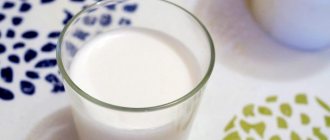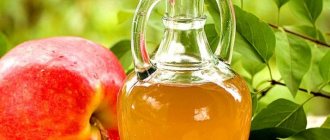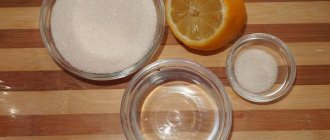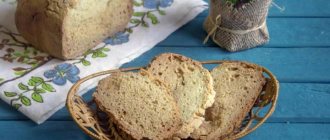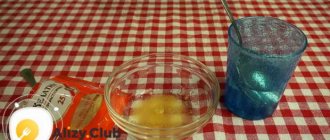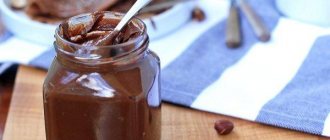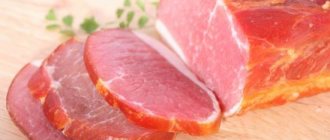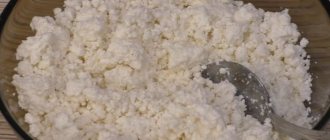0
Prepared by: Marina Shcherbakova
12/22/2015 Preparation time: 1 day. 14 hours 0 minutes
| Save | I cooked) | Estimate |
I suggest you try to make a very tender and tasty cheese yourself, with a pleasant milky taste. The cheese is ideal for canapés, appetizers, and also for salads. See the recipe!
Helpful tips for making delicious milk cheese with vinegar
When choosing products, it is better to give preference to homemade milk or take its store-bought counterpart with a fat content of at least 3.2%.
Important! To buy whole drinking milk, which does not contain vegetable fats, milk powder and other additives, pay attention to the expiration date - it does not exceed 10 days. The label should not contain the names “milk product” or “reconstituted milk.”
The second component, vinegar, coagulates the milk protein, and the cheese mass begins to separate from the whey. Typically, 9% table vinegar is used, but we advise you to give preference to organic types of vinegar, such as apple cider vinegar or white distilled vinegar. So the benefits will be many times greater.
When making cheese, microbiological purity is important. Pay special attention to the preparation of dishes, kitchen surfaces, cleanliness of gauze for straining and hands.
Important! From 3 liters of cow's milk, approximately 400-450 grams of semi-soft craft cheese are obtained. The remaining whey can be used to prepare other dishes (for example, baked goods).
How to make homemade cheese from cow's milk and vinegar
Making natural and healthy cheese at home is not difficult. To do this you only need three ingredients:
- 3 liters of milk (fat content of at least 3.2%);
- 100 ml 9% vinegar (or 150 ml 6% organic apple cider vinegar);
- 2 tbsp. spoons of salt.
Cooking process:
- Pour the milk into a thick-bottomed saucepan, bring to a boil and immediately remove from heat.
- Add salt, mix well.
- Begin to gradually pour in the vinegar while continuing to stir. The milk will begin to curdle quickly: the cheese curd will separate from the whey.
- Transfer the resulting mass to cheesecloth and leave to drain.
- When the liquid stops dripping, place the cheese mass in a container, cover and apply pressure (for example, you can use a jar of water). Place in the refrigerator for several hours, or better yet, overnight. You can taste it in the morning.
Note: This recipe can be used as a base recipe. Add finely chopped herbs (dill, parsley, cilantro), chopped nuts (walnuts, hazelnuts, almonds), spices, shallots, etc. to the milk. Just a little creativity and you will have a line of new flavors!
Interesting recipe: Healthy homemade mayonnaise with vinegar
How to make milk curdle
Milk curdles under the influence of lactic acid. We will classify this process as natural, because it occurs without our participation and is poorly controlled - we can only slow it down.
But what if the lactic acid bacteria worked poorly, or they did not have enough time to produce the coveted acid, or some other crazy reason prevented us from getting cottage cheese the easy way.
Yes, we need to add acid artificially.
Traditionally, two acids are used for this, which are, so to speak, at hand - citric and acetic. The milk is brought to a boil → acid is added → the milk is curdled. Everything seems simple. At first sight.
Homemade Adyghe cheese recipe
Using the same products, but changing the cheese-making technology, you can get another type of homemade cheese - Adyghe.
Ingredients: the same as in the previous recipe.
- Gradually pour vinegar into boiling milk, stirring constantly. There is no need to add salt at this stage!
- Line a colander with cheesecloth and place it over a clean, dry container. Place the cheese curd in a colander. Let the serum drain.
- Gently squeeze the cheese with your hands, put it in a small mold, cover, put pressure on top so that the cheese mass takes shape (you can leave it in the refrigerator for an hour).
- Meanwhile, prepare the brine: add salt to the whey, stir until it is completely dissolved.
- Place the cheese in the resulting solution so that the liquid completely covers it.
Cheese in brine is stored in the refrigerator for a maximum of 2-3 days, but is usually eaten before this period.
Homemade cheese
Brynza is a pickled cheese and is historically made from goat or sheep milk. This recipe has been adapted for something more accessible to customers – cow’s milk.
Ingredients:
- 2 liters of milk;
- 2 tbsp. spoons of cottage cheese;
- 2 tbsp. spoons of sour cream;
- 15 ml vinegar 9% (or 25 ml 6% organic apple cider vinegar);
- 1 teaspoon salt;
- 3-5 tbsp. spoons of salt for brine.
Cooking process:
- Bring the milk to a boil (you can remove it from the heat when steam comes from the surface).
- Pour a little milk (approximately 100-150 g) into a small container, add cottage cheese, mix well and pour the mixture into a common pan.
- Add sour cream and salt, pour in vinegar. Stir.
- Transfer the mixture to two-layer gauze and leave to drain, placing pressure on top.
- Prepare the brine separately: dissolve 3-5 tablespoons of salt in a liter of filtered water.
On a note! To understand that the solution is salty enough, dip a raw egg into it: if it floats, there is no need to add more salt.
After 2 hours, transfer the cheese mixture to the brine and leave in the refrigerator for at least 2 hours.
Good to know! If the cheese is too salty for your taste, just soak it in clean water or milk for 1-2 hours.
Maturing and storing cheese
In total, preparing young cheese from sour milk may require 3 hours of free time. The curd mass, suspended in gauze over the pan, should be kept in a cool place for at least two hours. The cheese obtained as a result of this manipulation will be quite loose. To make it crumble less when cutting, you need to put it in the refrigerator for at least 1 hour. If you keep it at low temperatures longer, it will begin to harden.
Cheese made from sour milk should be stored in the refrigerator for 7 to 10 days. It is recommended to wrap it in cling film or place it in brine. It keeps well open on a plate.
Goat cheese without rennet with vinegar
Unlike cow's milk, goat's milk is hypoallergenic and is better absorbed by the body - 5 times faster! This recipe does not require special enzymes.
Ingredients:
- 2l goat milk;
- 60 ml vinegar 9% (or 90 ml 6% apple cider vinegar);
- 2 tbsp. spoons of salt;
- a pinch of cumin.
Cooking process:
- While stirring constantly, pour the vinegar into the boiling milk.
- Transfer the separated cheese mass to cheesecloth, allowing the liquid to drain.
- Transfer the resulting cheese to a suitable container, mix with salt and cumin so that all ingredients are evenly distributed.
- Form the resulting mass into the desired shape and place it under pressure. Leave in the refrigerator for several hours.
Note: The consistency of the product can be adjusted by the severity of the pressure. For denser cheese, add a heavier weight.
What are the benefits of dairy products?
This type of cheese is rich in vitamins and minerals. This dairy product contains a huge amount of calcium, which helps strengthen bone tissue. In addition, regular consumption of calcium, which is present in this product, can minimize the risk of developing colon and breast cancer. Also the positive impact is as follows:
- reducing the likelihood of developing migraines;
- normalization of pressure;
- active participation in the normalization of the nervous system.
The composition contains a number of probiotics - biological microorganisms that have a positive effect on the functioning of the intestines in particular and the entire body as a whole. Probiotics also participate in the formation of the body’s natural defense – immunity.
Goat's milk cheese differs from other types of cheese in its low amount of cholesterol and sodium, so this product may be present in the diet of people with diabetes and a history of heart disease.
The product in question is quickly and easily absorbed by the body. The substances present in its composition stimulate rapid metabolism, thereby helping the body get rid of excess weight. And, of course, this variety is low in calories, so it is an ideal option for dietary nutrition.
It is also worth noting that this type of cheese is a hypoallergenic product, which is due to the lactoglobulins present in its composition. Therefore, people suffering from cow's lactose intolerance will be able to fully enjoy it without fear of consequences.
Instant cheese made from milk and apple cider vinegar
When you don’t want to go to the store or are short on time, you can quickly make cheese at home. It will take about 10 minutes for active cooking.
You will need:
- 3 liters of milk (fat content 3.2%);
- 150 ml apple cider vinegar 6%;
- 1 tbsp. spoon of salt;
- 1 teaspoon of sugar.
Cooking method:
- Pour milk into a saucepan and put on fire.
- Add salt and sugar, mix.
- Bring to a boil, pour in vinegar in a thin stream and turn off the heat, stirring constantly.
- Place the cheese mixture on cheesecloth and allow the hot whey to drain.
FAQ
Why can't you make homemade cheese from milk and vinegar?
A situation that may happen to a beginning amateur cheese maker is that the cheese “didn’t work out”: the cheese curd separates or falls apart. Most often, the reason may be low-quality milk (with vegetable fats and other additives) or insufficient amount of vinegar. Experiment with different dairy brands, adjust the amount of acetic acid, and the problem will be solved.
Important! Cheese easily absorbs any foreign odors, so it is not recommended to cook it at the same time as dishes with a pronounced aroma.
How and for how long should you store homemade cheese?
The advantage of homemade cheese is its naturalness. But, the absence of preservatives in the composition significantly shortens its shelf life. On average, no more than 2-3 days in a cool place (in the refrigerator).
The optimal solution would be to keep such a dairy product in salt brine. The salt concentration in the solution is enough to extend the shelf life to up to a week. The appearance of an unpleasant odor or a change in appearance should serve as a signal that the product has begun to deteriorate and can no longer be consumed.
What types of vinegar should you avoid using for homemade cheese?
To make cheese, you can use any type of vinegar, with the exception of rice vinegar. Any replacement will allow you to get a new taste of the product. Organic apple cider vinegar adds a sweet, fruity flavor. Wine (red and white) and balsamic will give the cheese a unique taste and color.
There are more than 500 types of cheese in the world. And none of them will probably repeat yours - prepared with your own hands with imagination and love!
Pasteurization and cheese making
Another important point. It is believed that natural milk is best suited for making cheese - it is both tastier and healthier. But! Natural milk can be parasitized by all sorts of pathogenic microorganisms that do not have the best effect on the human body.
To avoid danger, many cheese makers subject their raw materials to a process called pasteurization. During pasteurization, milk is subjected to thermal treatment - heating. Thanks to this, it is possible to minimize the presence of pathogenic bacteria in milk, as well as extend the shelf life of the product.
However, the pasteurization process disrupts the structure of milk protein, therefore, in order to achieve the required coagulability of milk, rennet is added to it after pasteurization.

